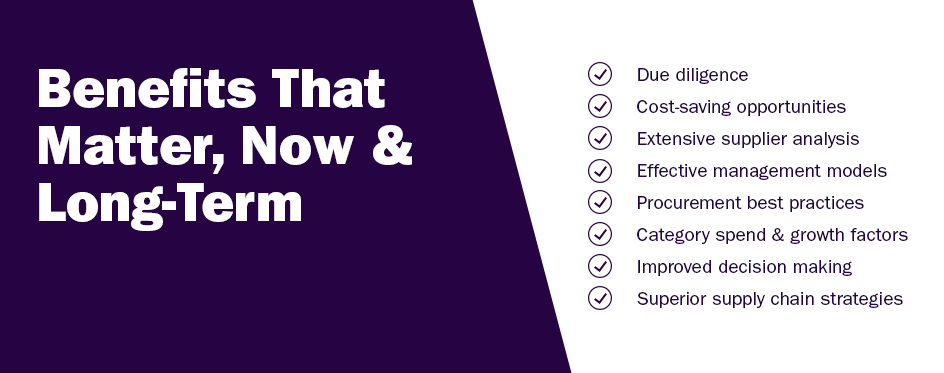The catering services market growth is driven by increasing demand for health and sustainable catering
Catering Services Procurement Intelligence
Catering service procurement has garnered immense popularity across emerging and advanced economies, largely due to the rise in events and weddings. The global market size was valued at USD 116.38 billion in 2023. The soaring popularity of online catering mostly drives the growth of the catering sector.
New habits are becoming ingrained and the taste for foreign meals is rising as the urban population grows. The worldwide fast-food sector is expanding as a result of a variety of reasons, including changing food preferences, the rise of online ordering and delivery, and an increase in the number of nuclear families. Consumers all around the world are experimenting with various cuisines as a result of exposure to other cultures and lifestyles, which is also opening up new growth potential for the global fast-food business.
Technologies such as food tracking & traceability and smart appliances are used by the companies. Ann Sather uses food tracking and traceability to ensure the safety and quality of their food and to track the food from the farm to the table, which can prevent foodborne illness. Aramark uses smart appliances, which helps them save time and energy as those appliances can be programmed to cook food automatically, and they can also be monitored remotely.
This industry is highly fragmented with a variety of large and small market players in the sector. These market players are launching new services and investing in merger and acquisition activities to grow their presence and market share. There are many minor market participants with sizeable market shares, and it is projected that they will significantly contribute to market expansion in the ensuing period.
Businesses typically use a fixed pricing structure for menu options. For the food and service, there is a set price per participant. This straightforward pricing approach provides clear explanations of the components and associated fixed rates, which are unaffected by size, scope, or preferences. This price structure is often used by both independently owned catering companies and restaurants with catering departments. This pricing strategy attracts clients as it is straightforward and sincere. Food and beverage costs make up the bulk of this market cost since businesses must buy the ingredients needed to cook food, and the price of those ingredients varies based on the required quality and quantity. Raw material accounts for 40% of the total cost. A catering service's transportation costs may vary depending on a number of factors, including the distance to be traveled, the size of the event, the type of food being transported, and the time of day.
One of the biggest markets is the U.S., where many companies provide services for weddings, business events, and other special occasions. Another significant competitor is the United Kingdom, which has a long history of providing catering for upscale occasions like state banquets and royal weddings. With numerous Michelin-starred chefs, Germany and France are renowned for their excellent cuisine and catering services. This industry is also expanding in China, which is anticipated to have significant growth over the next few years due to shifting consumer preferences and rising income levels.
Request a free sample copy or view report summary: Catering Services Procurement Intelligence Report
Catering Services Sourcing Intelligence Highlights
-
There are many small and major businesses operating in various regions, which has led to a highly fragmented industry for catering services globally. Players are in intense competition with one another as they try to increase their consumer base and provide better customer experiences.
-
Raw material and transportation & rental costs account for the largest cost component of the catering service business.
-
Fluctuations in raw material prices, such as vegetables, are expected to impact the service prices.
-
Most of the service providers offer complete services such as planning required for destination events, appropriate use & maintenance of equipment like utensils, and others.
Catering Service Procurement Intelligence Report Coverage
Grand View Research will cover the following aspects in the report:
-
Market Intelligence, along with emerging technology and the regulatory landscape
-
Market estimates and forecasts from 2024 to 2030
-
Growth opportunities, trends, and driver analysis
-
Supply chain analysis, supplier analysis with supplier ranking and positioning matrix, supplier’s recent developments
-
Porter’s 5 forces
-
Pricing and cost analysis, price trends, commodity price forecasting, cost structures, pricing model analysis, supply and demand analysis
-
Engagement and operating models, KPI, and SLA elements
-
LCC/BCC analysis and negotiation strategies
-
Peer benchmarking and product analysis
-
Market report in PDF, Excel, PPT, and online dashboard versions
Cost Intelligence Highlights
As part of the catering services procurement intelligence report, Grand View Research has identified the following key cost components:
-
Raw Material
-
Rental Cost
-
Personnel Cost
-
Associated Cost
-
Opportunity Cost
-
Wastage Cost
-
Transportation Cost
Raw material, rental cost, and transportation costs form the largest cost components of catering services.
Catering Services - Key Suppliers
-
Ann Sather
-
Aramark Corporation
-
Aria catering
-
AVI Food Systems
-
Bartlett Mitchell
-
Black Olive Catering
-
Blue Plate
-
CH and Co Catering Group
-
Compass Group
-
Delaware North Companies
Pricing & Purchase Options
Service Guarantee
-
Insured Buying
This report has a service guarantee. We stand by our report quality.
-
Confidentiality
Your transaction & personal information is safe and secure.
-
Custom research service
Design an exclusive study to serve your research needs.
-
24/5 Research support
Get your queries resolved from an industry expert.


